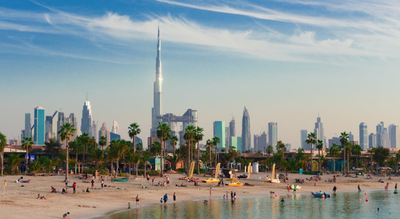ARTICLE AD BOX

Indians made up 22% of Dubai’s property buyers in 2024, investing roughly AED 35 billion (₹84,000 crore), with over 29,000 buyers owning more than 35,000 homes/ Image: Pexels
Dubai, once the playground of India’s high net-worth elite, is now seeing a very different kind of investor. The city that once sold penthouses to film stars and billionaires has quietly become the next big wealth strategy for India’s middle tier.
With smart financial planning and easier cross-border access, salaried professionals and small business owners are now buying into what was once a distant dream, foreign property ownership. A decade ago, the idea of an Indian middle-class couple owning a flat in Dubai seemed fanciful. Today, it’s a growing reality, enabled by structured developer payment plans, lower interest rates, and the promise of tax-free income.
What was once aspirational has become tactical.
The new middle-class playbook
The new wave of Indian buyers is not chasing glamour; they’re chasing returns and security. The logic is straightforward: in Indian metros, home loans come with 9–10 per cent interest and rental yields barely touch 3 per cent. A ₹2 crore apartment in Mumbai might rent for ₹50,000 a month, just enough to cover maintenance and part of the EMI. In Dubai, the same ₹2 crore (around AED 830,000) can buy a one-bedroom flat in areas like Jumeirah Village Circle or Dubai South, with rental yields averaging 7–9 per cent.
A one-million-dirham property (₹2.4 crore) that rents for AED 7,500 a month (₹1.8 lakh) generates a 9 per cent gross return. Mortgage rates hover near 5 per cent, leaving room for profit and savings. Developers make the entry easier: many offer staggered post-handover payment plans, with 20 per cent down and the rest spread across five to ten years. That structure lets middle-income families begin investing without having full capital upfront. In effect, Dubai has created a bridge between aspiration and affordability, a chance for disciplined middle-tier investors to build offshore assets without being millionaires.
Why Dubai works
Dubai’s appeal lies in the way it turns predictability into a financial virtue. Rental income is tax-free. There are no annual property taxes, no capital-gains tax, and no stamp duty beyond a one-time 4 per cent Dubai Land Department (DLD) registration fee, cheaper than the 6–7 per cent stamp duty common in Indian cities. The numbers tell their own story. Indians accounted for 22 per cent of all Dubai property transactions in 2024, investing roughly AED 35 billion (₹84,000 crore). Over 29,000 Indian buyers now collectively own more than 35,000 homes in the emirate. In yield terms, Dubai’s residential properties average 5–11 per cent, depending on area, while India’s hover between 3–5 per cent. The city’s fundamentals support the optimism. Its population has doubled from 2 million in 2011 to 4 million in 2025 and is projected to reach 5 million by 2030.
Massive infrastructure commitments, such as the expansion of Al Maktoum International Airport, soon to be the world’s largest, keep fuelling demand.Beyond rental income, Dubai’s off-plan market also allows investors to flip properties without penalties or added costs. Buyers can invest early with around 40 per cent of the property’s value, and if prices rise before completion, developers often repurchase the unit at prevailing market rates.
This flexible resale system has become a significant attraction for Indian investors seeking short- to medium-term gains without waiting years for possession. Then there’s the Golden Visa: an AED 2 million (₹4.8 crore) property purchase now qualifies investors for a renewable five- or ten-year residency permit. Since its expansion in 2022, Golden Visa issuances have doubled to roughly 158,000 in 2023, with Indians forming one of the largest applicant groups.
For many families, this offers not just returns but residency flexibility and access to education and healthcare. Dubai’s rules also favour transparency. Property titles are digital, escrow accounts are mandatory, and completion timelines are monitored, a stark contrast to the legacy delays that once defined Indian projects.
What an investment looks like
A typical mid-tier Dubai property purchase runs between AED 1–3 million (₹2.4–7.2 crore).
Most buyers start with a 20 per cent down payment (₹35–50 lakh) and finance the remainder through UAE banks or structured developer plans. The math can look like this:
- Purchase price: AED 1.5 million (₹3.6 crore)
- Rental yield: 8 per cent (≈ AED 120,000 or ₹28.8 lakh annually)
- Mortgage rate: ~5 per cent
- Net return (after loan cost): 3–4 per cent in cash flow plus capital appreciation potential
That return may not sound spectacular, but when combined with zero property tax, stable currency, and potential visa benefits, it becomes a compelling diversification move for households already exposed to Indian assets. The process itself is friction-light: all registration is handled via the Dubai Land Department’s online portal.
Title certificates are issued electronically within days. Buyers can manage the transaction remotely, a level of digital efficiency still rare in India’s fragmented property market.
The India context: A market maturing at home
India’s real-estate ecosystem has, in fairness, come a long way. Regulatory frameworks like RERA, digitised land records, and GST compliance have reduced opacity. Property prices in cities such as Mumbai and Delhi-NCR have grown around 8 per cent annually since 2020, a healthy clip by developed-market standards. What’s changing even faster is financial access. The emergence of Real Estate Investment Trusts (REITs) has opened a formalised path for smaller investors to earn rental income from Grade-A commercial assets. India’s listed REITs, including Embassy, Mindspace, and Brookfield, have generated 10–13 per cent annual total returns in the past five years, with 6–8 per cent paid as regular distributions. REITs are not a direct substitute for property ownership, but they represent India’s version of democratised real-estate investment, transparent, liquid, and regulated.
For those wary of currency risk or compliance complexity, they serve as a domestic counterpart to the offshore property boom. Meanwhile, urban redevelopment and infrastructure spending, metro corridors, expressways, and affordable-housing schemes, are creating genuine end-user demand that underpins longer-term value.
Reading the fine print
Dubai’s boom, however, comes with its cautions. The 2008 financial crisis is still a reminder of how quickly speculative cycles can reverse; property prices then fell nearly 50 per cent.
The current surge, fuelled by foreign inflows, has similar energy. For Indian investors, several practical checks are essential:
- LRS limits: Only USD 250,000 (≈ ₹2.1 crore) per person can be remitted abroad annually under India’s Liberalised Remittance Scheme. Larger purchases often need joint accounts or phased payments.
- TCS and taxation: Remittances above ₹10 lakh attract a 5 per cent Tax Collected at Source, though this can be adjusted later in filings. Dubai rental income must still be declared in India if the investor remains tax-resident there.
- Service costs: Annual maintenance charges can reach AED 30 per sq ft (₹720 per sq ft), varying by property.
- Currency exposure: With the dirham pegged to the US dollar, a weakening rupee increases both entry cost and loan repayments.
Caution isn’t pessimism; it’s calibration. The key lies in realistic planning and diversification rather than treating Dubai property as a guaranteed goldmine.
A balanced horizon
Dubai’s rise as an investment magnet says as much about India’s economic maturity as it does about the Gulf’s opportunity.
As Indian professionals earn more, save more, and think globally, cross-border asset building is a natural evolution. Yet the flow is not one-way. India’s own real-estate landscape is formalising, and its REIT ecosystem offers institutional-grade exposure without geographic risk. In time, both markets may find equilibrium., Dubai as a tax-efficient satellite and India as a robust home base. For now, though, the message is clear: the democratisation of global property ownership is underway. Dubai may have been built by oil and ambition, but its next chapter is being written, quietly and steadily, by India’s middle class, one well-planned investment at a time.

 1 hour ago
6
1 hour ago
6









 English (US) ·
English (US) ·